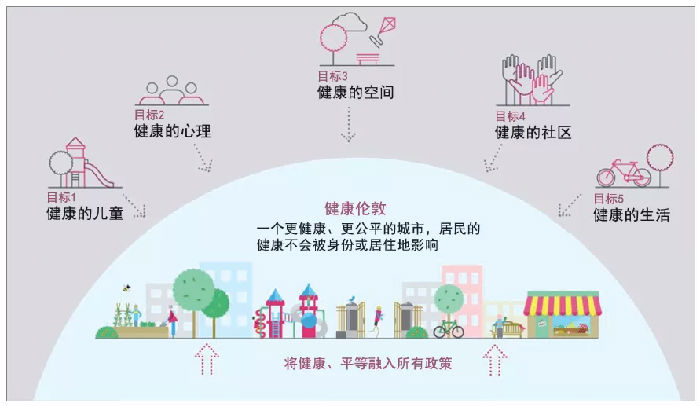


3 Planning actions to address climate change-induced health risks
The New Urban Agenda proposes strategies to address climate change health risks in three areas: building urban governance structures, planning and managing urban spatial development, and concrete means of implementation. The urban governance structure is based on the urban policy system, the planning and management of urban spatial development focuses on urban spatial planning and design, and the specific means of implementation include technical means and implementation strategies. In recent years, a series of planning research and practice activities have been carried out around the world under the advocacy of the New Urban Agenda to respond to the health risks caused by climate change. In this paper, we summarize their experiences of planning actions in response to the New Urban Agenda from the perspective of climate change-related health risks.
3.1 Planning policy management
Planning policy management focuses on direct health risks from climate change, including climate adaptation policies aimed at adapting to climate change and health promotion policies to improve the health of citizens.
3.1.1 Climate adaptation policies
Climate adaptation policies are effective initiatives taken by cities to address the immediate health risks posed by climate change, enhancing the resilience of cities and the public to risks by increasing urban resilience and public awareness of risks.
(1) Urban climate change risk response policies. New York focuses on flood and heat risks and promotes resilient cities, with more than 250 initiatives and nearly $20 billion invested in climate change response and resilient city planning improvements, including further protection of coastlines and support for the provision of critical systems for urban life, including energy networks, transportation systems, telecommunications networks and health systems. London presented its Strategy for Managing Disaster Risk and Improving Urban Resilience, which focuses on three categories of climate risk (i.e. floods, heat and drought) and proposes specific action plans for each of the four key areas most affected by climate change (economy, environment, health and infrastructure) in terms of prevention, preparedness, response and recovery, based on a systematic assessment of climate change impacts. The Municipality of Rotterdam is concerned about the negative impacts of climate change on the health and well-being of its citizens and proposes adaptation actions to address climate change based on the identification of urban climate risks (sea level rise, heavy rainfall, prolonged droughts and high temperatures), with health as one of the key objectives of the action; and prioritizes the protection of the "green heart" policy. It further proposes eight lines of action in the areas of climate change alliance building, climate adaptation and climate mitigation, and embeds climate considerations in foreign policy, such as the development of climate-friendly agriculture and horticulture.
(2) Public climate change risk response policies. The London Environment Strategy states that infrastructure providers and businesses should understand and reduce the health risks and adverse impacts of climate change by providing resilient infrastructure services; that appropriate flood prevention measures are in place to reduce the risk from flooding by raising awareness of flooding; that water supplies must be efficient, safe, resilient and affordable; and that people must be better prepared for extreme heat events and rising temperatures The population must be better prepared for extreme heat events and rising temperatures. Rotterdam has made raising risk awareness among its residents one of the main objectives of its adaptation strategy, noting that Rotterdam residents need to be aware of the adverse effects of climate change and understand their responsibilities and the effective measures they can take.
3.1.2 Health promotion policies
The health risks associated with climate change have begun to receive widespread public attention, and health promotion policies can improve the health of urban residents, thereby increasing their ability to cope with the risks and thus better protect people's health. Specific measures include the implementation of health promotion programs, the development of policies to address the inequitable nature of climate change-induced health risks and the conduct of health impact assessments.
(1) Implementation of health promotion programs. The United States released the "Healthy Citizen 2030 Plan", which identifies climate change-induced health risks as an emerging issue in environmental health, and identifies air pollution, water pollution and heat waves as three environmental conditions that negatively affect public health. and prioritizes 23 of the core indicators for development in order to improve the health of citizens over the next 10 years. In addition, the plan proposes specific practical ways to improve the health and well-being of citizens.
(2) Developing policies to address inequities in health risks arising from climate change. London has published the Mayor of London's Health Inequalities Strategy, with a vision to make London a healthier and fairer city. The strategy sets out a range of policies to address non-genetic factors that affect health, such as climate change, as well as five key objectives (Figure 1), with a focus on climate change-induced health risks within the Healthy Spaces objective, and proposes measures to address them, namely improving air quality, reducing health risks to vulnerable groups from climate change, and working to ensure that more than half of London has a tree canopy (Figure 2)。 The aim is to improve air quality, reduce the health risks of climate change for vulnerable groups and work to ensure that more than half of London has a 10 per cent increase in tree cover by 2050.

Figure 1 Schematic representation of the 5 objectives of the Mayor of London's Health Inequalities Strategy
(3) Conducting health impact assessments. Health impact policies have been incorporated into national health policy development in a number of countries. Among them, the UK government recognises the importance of conducting health impact assessments for public health and has included it as a key focus in national policy, and is actively engaged in health impact assessment activities led by the government and the Department of Health to address the health impacts of climate change and its responses. In 2019, the Netherlands' first research policy on the topic of climate change and health - The Climate and Health Knowledge Agenda, which focuses on the health impacts of climate change and its responses, identifies the following priority themes based on literature, questionnaires and interview surveys: integrated analysis and prediction of current and future health risks from climate change, development, implementation and evaluation of responses to this risk, development and application of integrated monitoring and evaluation systems, and standard health impact assessments in climate response measures and climate mitigation standard health impact assessments in climate response measures and climate mitigation measures.
Source:https://mp.weixin.qq.com/s/waTeo8GvMFyXtcP9co8sEw
Translated by Chen Yan